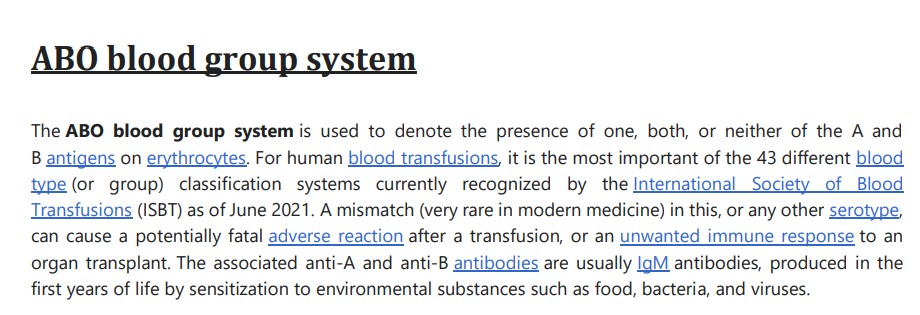ABO Blood Grouping System
Summary:
The ABO blood grouping system is named after the ABO antigens present on the surface of erythrocytes. These antigens, A and B, are carbohydrate chains that are attached to proteins and lipids that make up the erythrocyte membrane. An individual’s blood type is determined by the presence or absence of these antigens on their erythrocytes. The ABO blood group system is essential in determining the compatibility of blood transfusions and organ transplants. A mismatch in the ABO blood group system, although rare in modern medicine, can cause potentially fatal adverse reactions, making it crucial to match the donor’s and recipient’s blood types before any transfusion or transplant.
The ABO blood type system is also associated with the presence of IgM antibodies in the serum. Anti-A and anti-B antibodies are produced in the first few years of life by sensitization to environmental substances such as food, bacteria, and viruses. The presence of these antibodies in the serum of an individual is used to determine their blood type. For example, if an individual has anti-A antibodies in their serum, they are classified as blood type B or O, while the presence of anti-B antibodies identifies individuals as blood type A or O.
The discovery of the ABO blood type system is attributed to Karl Landsteiner, an Austrian biologist and physician, who identified the A and B antigens in 1901.
Excerpt:
ABO Blood Grouping System
The ABO blood grouping system is used to denote the presence of one, both, or neither of the A and B antigens on erythrocytes. Human blood transfusions are the most important of the 43 different blood type (or group) classification systems currently recognized by the International Society of Blood Transfusions (ISBT) as of June 2021. A mismatch (very rare in modern medicine) in this, or any other serotype, can cause a potentially fatal adverse reaction after a transfusion or an unwanted immune response to an organ transplant. The associated anti-A and anti-B antibodies are usually IgM antibodies, produced in the first years of life by sensitization to environmental substances such as food, bacteria, and viruses.


Reviews